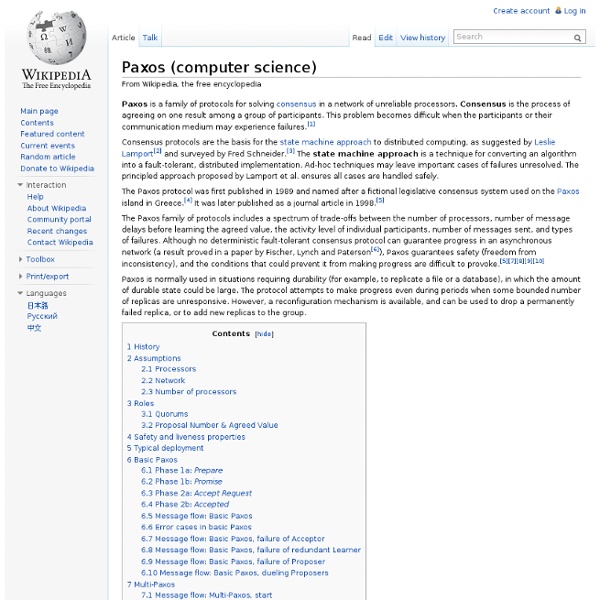Paxos (computer science)

Chandra–Toueg consensus algorithm
The algorithm[edit] The algorithm proceeds in rounds and uses a rotating coordinator: in each round r, the process whose identity is given by r mod n is chosen as the coordinator. Each process keeps track of its current preferred decision value (initially equal to the input of the process) and the last round where it changed its decision value (the value's timestamp). The actions carried out in each round are: All processes send (r, preference, timestamp) to the coordinator.The coordinator waits to receive messages from at least half of the processes (including itself). It then chooses as its preference a value with the most recent timestamp among those sent.The coordinator sends (r, preference) to all processes.Each process waits to receive (r, preference) from the coordinator or for its failure detector to identify the coordinator as crashed. Why it works[edit] Agreement is trickier. References[edit]
Rough consensus
Rough consensus is a term used in consensus decision-making to indicate the "sense of the group" concerning a particular matter under consideration. It has been defined as the "dominant view" of a group as determined by its chairperson. The term was first used by the Internet Engineering Task Force (IETF) in describing its procedures for working groups (WGs). The means to establish rough consensus was described by the IETF as follows:[1] Working groups make decisions through a "rough consensus" process. IETF consensus does not require that all participants agree although this is, of course, preferred. The phrase is often extended into the saying "rough consensus and running code",[2] to make it clear that the IETF is interested in practical, working systems that can be quickly implemented.
Consensus
Un article de Wikipédia, l'encyclopédie libre. Un consensus est un accord des volontés sans aucune opposition formelle. Le consensus se distingue de l'unanimité qui met en évidence la volonté manifeste de tous les membres dans l'accord. Un consensus caractérise l'existence parmi les membres d'un groupe d'un accord général (tacite ou manifeste), positif et unanime pouvant permettre de prendre une décision ou d'agir ensemble sans vote préalable ou délibération particulière. Bien qu'en principe le consensus désigne un accord positif et unanime, l'usage récent a consacré des sens dérivés : §Étymologie[modifier | modifier le code] Consensus est un mot latin qui signifie « accord », au sens de « sentiment commun ». Du fait du changement de sens récent qui fait que le terme consensus se dissocie de l'unanimité ou de la quasi-unanimité, on en vient à parler de « consensus absolu » ou de « consensus parfait » pour désigner un accord qui ne recueille aucune opposition. §Droit de veto ou permission ?
Related:
Related:



